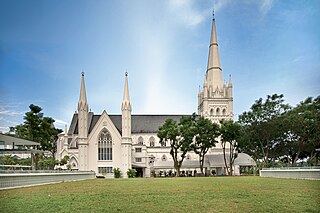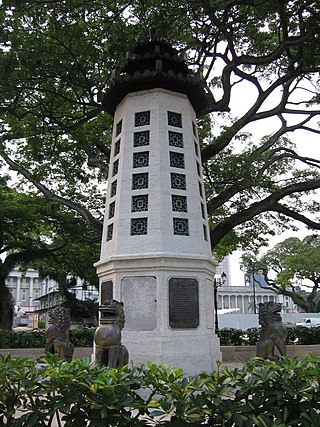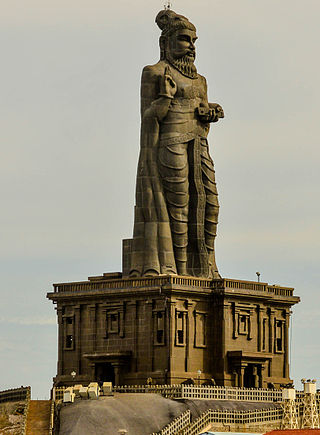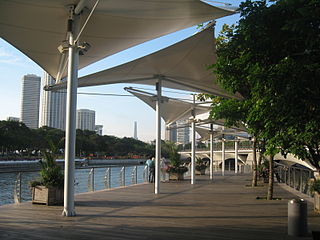
The Albert Memorial, directly north of the Royal Albert Hall in Kensington Gardens, London, was commissioned by Queen Victoria in memory of her beloved husband Prince Albert, who died in 1861. Designed by Sir George Gilbert Scott in the Gothic Revival style, it takes the form of an ornate canopy or pavilion 176 feet (54 m) tall, in the style of a Gothic ciborium over the high altar of a church, sheltering a statue of the prince facing south. It took over ten years to complete, the £120,000 cost met by public subscription.

Raffles Institution (RI) is an independent educational institution in Singapore. Founded in 1823, it is the oldest school in the country. It provides secondary education for boys only from Year 1 to Year 4, and pre-university education for both boys and girls in Year 5 and Year 6. Since 2007, RI and its affiliated school Raffles Girls' School have been offering the six-year Raffles Programme, which allows students to skip the Singapore-Cambridge GCE O-Level examinations and proceed to take the Singapore-Cambridge GCE A-Level examinations at the end of Year 6.

Saint Andrew's Cathedral is an Anglican cathedral in Singapore. It is located near City Hall, Downtown Core, within the Central Area in Singapore's central business district. It is the main cathedral church of the Anglican Diocese of Singapore and serves as the mother church of 27 parishes and more than 55 congregations. The church has existed on the site since 1836, although the current building was constructed in 1856–1861. The logo of the cathedral is the St Andrew's Cross.

Ais kacang, literally meaning "bean ice", also commonly known as ABC, is a Malaysian dessert which is common in Malaysia, Singapore and Brunei.

The Esplanade is a waterfront location just north of the mouth of the Singapore River in downtown Singapore. It is primarily occupied by the Esplanade Park, and was the venue for one of Singapore's largest congregation of satay outlets until their relocation to Clarke Quay as a result of the construction of a major performance arts venue, the Esplanade - Theatres on the Bay, which took its name from this location.
Yusof bin Ishak was a Singaporean politician and journalist who served as the first president of Singapore between 1965 and 1970.

The Kranji War Memorial is located at 9 Woodlands Road, in Kranji in northern Singapore. Dedicated to the men and women from the United Kingdom, Australia, Canada, Sri Lanka, India, Malaya, the Netherlands and New Zealand who died defending Singapore and Malaya against the invading Japanese forces during World War II, it comprises the War Graves, the Memorial Walls, the State Cemetery, and the Military Graves.

Clifford Pier was a former pier located beside Collyer Quay at Marina Bay within the Downtown Core of the Central Area, Singapore. The pier, which opened in 1933, ceased operations in 2006.

The Martin Luther King, Jr. Memorial is a national memorial located in West Potomac Park next to the National Mall in Washington, D.C., United States. It covers four acres (1.6 ha) and includes the Stone of Hope, a granite statue of Civil Rights Movement leader Martin Luther King Jr. carved by sculptor Lei Yixin. The inspiration for the memorial design is a line from King's "I Have a Dream" speech: "Out of the mountain of despair, a stone of hope." The memorial opened to the public on August 22, 2011, after more than two decades of planning, fund-raising, and construction.

The Lim Bo Seng Memorial is an octagonal pagoda-like war memorial at Esplanade Park, Singapore. It was erected in 1954 in honour of the late Lim Bo Seng for his heroic acts and selfless sacrifice during the World War II. The war memorial is the only structure in Singapore that commemorates an individual's efforts in World War II and was gazetted as a national monument on 28 December 2010.

The Thiruvalluvar Statue, or the Valluvar Statue, is a 41-metre-tall (133 ft) stone sculpture of the Tamil poet and philosopher Valluvar, author of the Tirukkural, an ancient Tamil work on Dharma and morality. It is located atop a small island near the town of Kanniyakumari on the southernmost point of the Indian peninsula on the Coromandel Coast, where two seas and an ocean meet. The statue was sculpted by the Indian sculptor V. Ganapati Sthapati, who also created the Iraivan Temple, and was unveiled on the millennium day of 1 January 2000 by the then Chief Minister M. Karunanidhi. It is currently the 25th tallest statue in India.

The Old National Library Building was a demolished historical library building at Stamford Road in the Museum Planning Area of Singapore. Originally completed in 1960, the library building was a national icon for many Singaporeans. Despite a huge groundswell of public dissent, the library was closed on 31 March 2004, and was demolished in July that year to make way for the construction of the Fort Canning Tunnel to ease road traffic to the city. The controversy surrounding the building's demise has been credited for sparking greater awareness of local cultural roots and an unprecedented wave in favour of heritage conservation among Singaporeans.

The Fullerton Hotel Singapore is a five-star luxury hotel located near the mouth of the Singapore River, in the Downtown Core of the Central Area, Singapore. It was originally known as the Fullerton Building, and also as the General Post Office Building. The address is 1 Fullerton Square. The Fullerton Building was named after Robert Fullerton, the first Governor of the Straits Settlements (1826–1829). Commissioned in 1924 as part of the British colony's centennial celebrations, the building was designed as an office building by Major P.H. Keys of Keys & Dowdeswell, a Shanghai firm of architects, which won the project through an architectural design competition. The architectural firm also designed the Capitol Theatre, its adjoined Capitol Building and the Singapore General Hospital. In 2015, it is gazetted as a national monument of Singapore.

Lei Yixin is a prominent Chinese sculptor. Yixin designed the Stone of Hope, the statue of Martin Luther King Jr. at the King Memorial near the United States National Mall.

Collyer Monument is an historic monument to firefighters in Mineral Spring Park, at the corner of Mineral Spring Avenue and Main Street, in Pawtucket, Rhode Island, United States. The monument was built in 1890 by the sculptor Charles Parker Dowler to honor Samuel Smith Collyer, a fallen Pawtucket Fire Chief. The life-size bronze sculpture stands atop a pedestal of Westerly granite, which has a bronze plaque depicting the fatal accident while the reverse bears an inscription. The memorial represents a significant example of monumental work of the period and an early example of local civic pride. The monument was added to the National Register of Historic Places in 1983.
Lien Ying Chow, George, was a Singaporean businessperson. He is one of the founders of Overseas Chinese Union Bank, which merged with United Overseas Bank in 2001.

The Tan Kim Seng Fountain is a fountain in Singapore that was erected in 1882 in honor of notable philanthropist Tan Kim Seng for his donations for the Singapore's first reservoir and waterworks.

Waterboat House Garden is a small park located near the mouth of the Singapore River, near the Central Business District (CBD) in Singapore. The park was once the original site of the former Merlion Park where the two iconic statues of the Merlion and its miniature form were originally located.
The Founders' Memorial is a memorial under development within the Bay East Garden of the Gardens by the Bay to commemorate the founding fathers of Singapore as well as to cover the country's contemporary history from after World War II to its first few decades of independence.

The Jubilee Memorial, Harrogate, is a Grade II listed building. It is a Gothic Revival stone memorial in Harrogate, North Yorkshire, England, commemorating the 1887 golden jubilee of Queen Victoria. It was donated to Harrogate by its mayor, Richard Ellis, designed by architect Arthur Bown, and unveiled by the Marquis of Ripon.





















